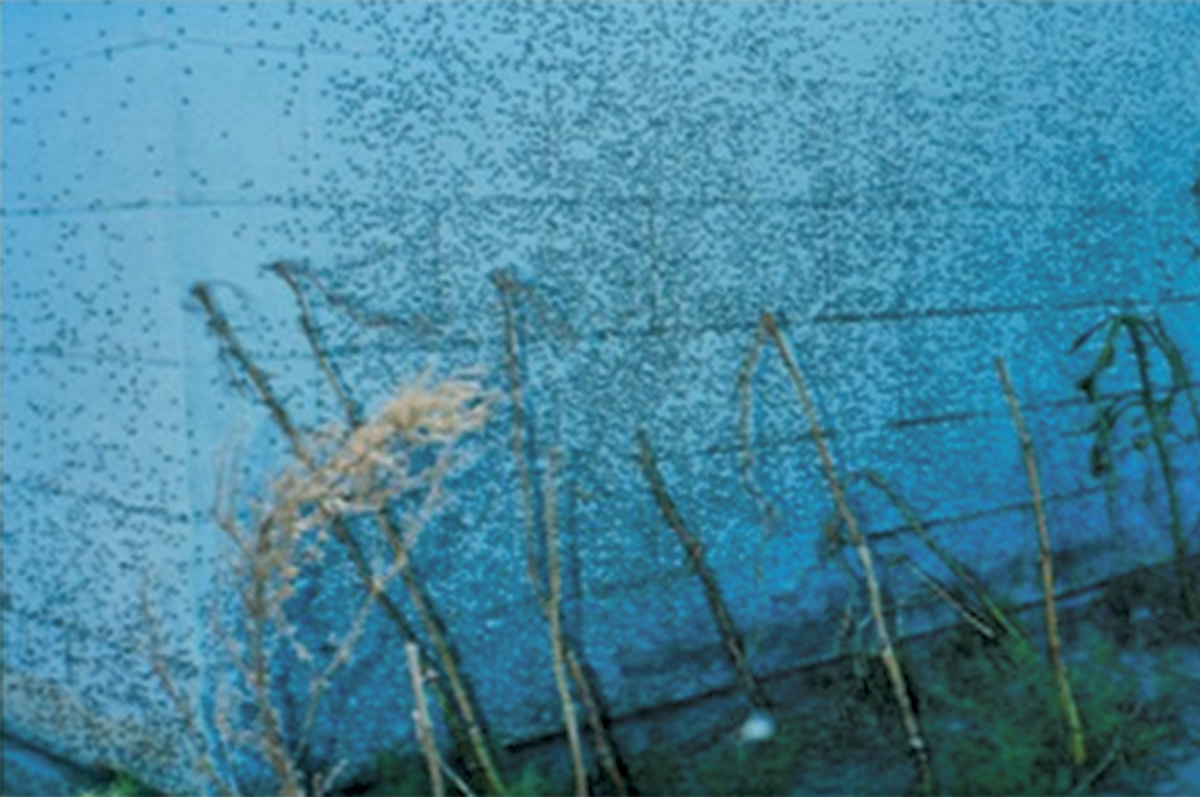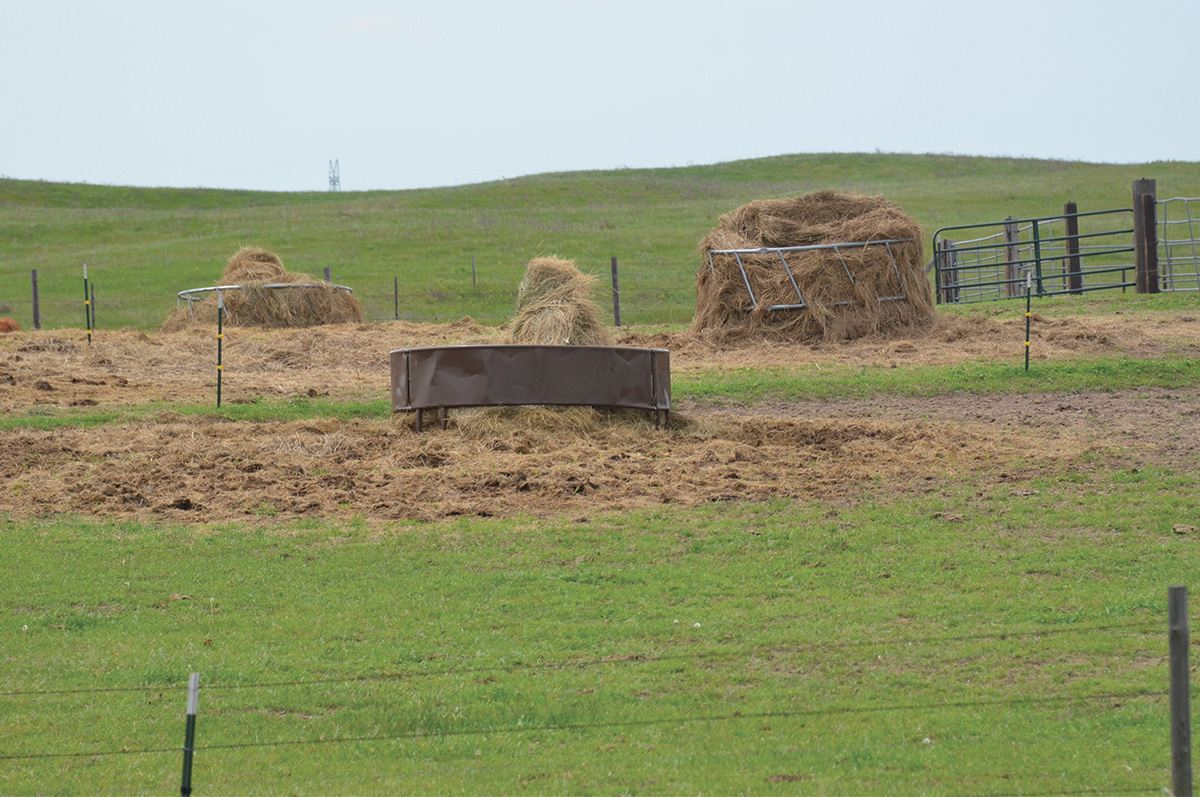Pastured animals that exhibit defensive behaviors such as tail flicking, skin twitching, leg stamping, lying with their legs tucked underneath, standing in water and bunching in corners of pastures are likely being attacked by the stable fly. Animals bunching to fight stable flies can damage forage and on fragile soils may create blowouts. Historically, stable flies had only been pests of cattle in dairies and feedlots.
Since the 1980s, stable flies have emerged to be a serious pest of pastured cattle. This coincided with livestock producers transitioning away from small hay bales to large round bales in stationary feeders. Research studies indicated this transition increased stable fly numbers found in pastures because leftover piles of hay mixed with animal urine and manure create an ideal environment for stable fly larval development. However, other larval-developing sites may also contribute to pasture populations.
Both sexes of the stable fly require a blood meal, usually twice a day depending upon the weather. They prefer to feed on the legs and the belly area of pastured animals. After feeding, the stable fly will seek a shaded resting site to digest the blood meal. In pastures, this could be windbreaks (coniferous or deciduous), walls of structures, windmill towers and water tanks (photo below).

Stable flies rest on a shaded area of a small building. Photo by Dave Boxler.
While the impact of stable flies on the performance of dairy and confined cattle has been well documented, stable fly impact on pastured cattle has been less examined. A pasture study conducted at the University of Nebraska in the late 1990s saw a reduced average daily gain (ADG) of 0.44 pound in three 84-day trials with cattle receiving no insecticide treatment versus cattle that received a treatment. An economic injury level (EIL) of five flies per leg has been suggested and is often exceeded in normal pasture conditions. The EIL may be less based on the results of the above study, where stable fly numbers averaged 3.6 flies per leg.

A stable fly rests on a board, its piercing/sucking mouthpart protruding in front of the head. The swollen abdomen indicates a recent blood meal. Photo by Dave Boxler.
The stable fly is similar in size to the house fly but is dark gray and has dark irregular spots on its abdomen. The proboscis (mouthpart) protrudes bayonet-like in front of the head (photo above). The larvae are typically whitish in color. The pupae are chestnut brown and about 1/4-inch long. The complete life cycle from egg to adult is 14 to 24 days (about three-and-a-half weeks) depending upon weather. The female deposits eggs in spoiled or fermenting organic matter sometimes mixed with animal manure, moisture and dirt. The most common developing sites are in feedlots or dairy lots, usually around feedbunks, along the edges of feeding aprons, under fences and along stacks of hay, alfalfa and straw. Grass clippings and poorly managed compost piles also provide ideal larval-developing sites. In pasture settings, winter hay feeding sites where hay rings are used can often be a source for stable flies through the summer if moisture is present (photo below).

A winter hay feeding site is an excellent stable fly larval development area if moisture is present. Photo by Dave Boxler.
Adult stable flies normally survive less than two weeks in the field. Adults can be active year-round in some locations, but numbers usually decline as daily maximum temperatures increase to above 86°F. In temperate regions, stable fly populations tend to peak in early summer and late summer. In more northern sites, one population peak can be observed in midsummer. In more southern, warmer regions, a single peak occurs in late winter or spring. Temperature and moisture appear to be the main factors that affect stable fly population fluctuations. Stable flies are strong fliers. Stable fly dispersal distances can be as short as 1 to 3 miles or they can extend 140 miles or more with weather frontal systems. Actual dispersal distances appear to be determined by the distance the stable fly must travel to find hosts. While the source of early season flies is not well understood, some develop from native overwintering larvae. Other early season flies may migrate from southern locations, but definitive evidence is lacking.
Management
Pasture stable fly management presents exceptional challenges. Stable flies are on the host for relatively short periods of time and tend to congregate on the lower parts of the legs and belly area. Targeting these areas with many of the common treatment methods is challenging and often unsuccessful in reducing fly numbers. Immature or larval development sites are sometimes difficult to locate, as they often originate a significant distance from where the adults are feeding on a host animal.
Chemical
Direct applications of animal sprays are the most effective means of reducing adult stable fly numbers; however, the effectiveness is sometimes weak and brief. Animal applications can be made with a low-pressure sprayer or a mist blower. Insecticides labeled for this type of application include organophosphates and pyrethroids. Multiple applications may be required during the fly season to reduce fly numbers. Stable fly resting sites can also be targeted for treatment. These include sides of buildings or wooden fencelines and windbreaks. Treed windbreaks offer an ideal resting site during warm afternoons; these sites could be sprayed using a low-pressure or mist blower sprayer targeting foliage, using a natural pyrethrin or synthetic pyrethroid. Spray applications around and on water tanks should not be made. Insecticides registered for stable fly use varies by state and can be found on the Veterinary Entomology website. Please follow label recommendations before applying any control product.
Traps
Fly traps have been used in confined settings to help reduce stable fly numbers. In pasture settings, traps are currently being evaluated. One must consider when placing traps where to place them in the pasture, how many traps are required per head of cattle and the frequency of service or replacement. Studies are being conducted to answer these questions. The Starbar Bite Free and the Knight Stick are two commercially available pre-glued stable fly traps. Locating these traps where cattle loaf or near sources of water might help reduce fly numbers. Traps need to be monitored and maintained on a regular basis.
Larvicide
Cleanup of spillage and waste around hay rings should be done well before the presence of stable flies is observed on pastured cattle. Wasted material should be collected and spread in a thin manner to reduce larval development. If sanitation is not possible, a larvicide such as Cyromazine could be applied to the larval development site.
The information given in this article is for educational purposes only. Reference to commercial products or trade names is made with an understanding that no discrimination is intended, and no endorsement is implied.







